Worksheet: Pressure, Winds, Storms, and Cyclones | Worksheets with Solutions for Class 8 PDF Download
| Table of contents |

|
| Multiple Choice Questions (MCQs) |

|
| Fill in the Blanks |

|
| Very Short Answer Questions |

|
| Short Answer Questions |

|
| Long Answer Questions |

|
| Match the Following |

|
Multiple Choice Questions (MCQs)
Instruction: Select the correct option for each question.
Q1. Pressure is defined as:
a) Force × area
b) Force / area
c) Area / force
d) Mass × acceleration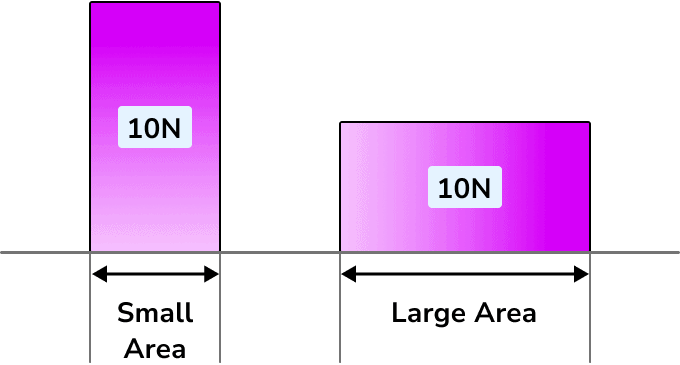 Pressure depends on Force and Area
Pressure depends on Force and Area
Q2. Why do broader bag straps feel more comfortable than narrow ones for the same load?
a) They reduce the force
b) They increase pressure
c) They decrease pressure by increasing area
d) They change the weight
Q3. SI unit of pressure is:
a) Newton (N)
b) Joule (J)
c) Pascal (Pa)
d) Watt (W)
Q4. Liquid pressure at a point depends mainly on:
a) Shape of container
b) Color of liquid
c) Height (depth) of the liquid column
d) Total volume of liquid
Q5. Which activity shows that liquids exert pressure on the walls?
a) Balloon inflating
b) Water jetting sideways from holes in a bottle
c) Magnet attracting iron
d) Ice melting
Q6. Atmospheric pressure is the pressure exerted by:
a) Water only
b) Rocks of Earth
c) Air around us in all directions
d) Only wind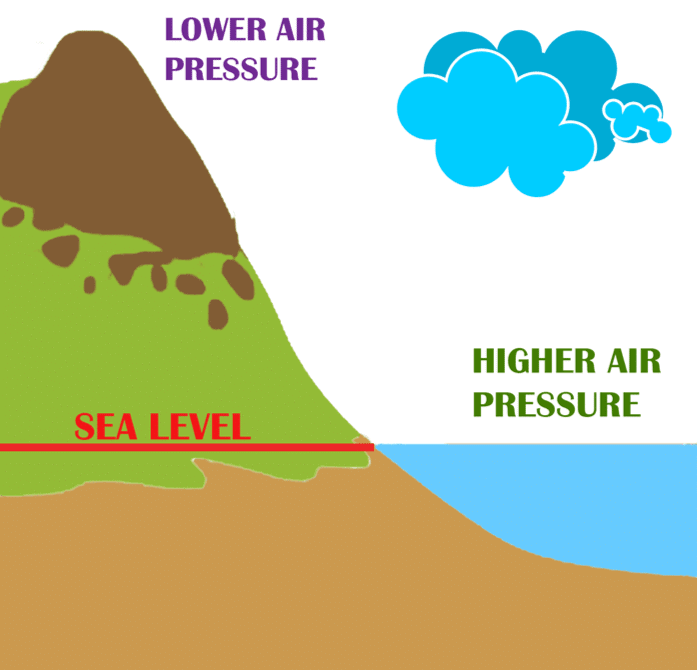 Atmospheric Pressure
Atmospheric Pressure
Q7. Air moves from a region of:
a) Low pressure to high pressure
b) High pressure to low pressure
c) High temperature to low temperature only
d) Low density to high density only
Q8. During the day at the coast, a sea breeze blows because:
a) Sea heats faster than land
b) Land heats faster; air rises over land creating low pressure
c) Air pressure over sea is always low
d) Earth stops rotating
Q9. High-speed winds between two hanging balloons make them move closer because:
a) Gravity increases
b) Pressure between them increases
c) Pressure between them decreases due to fast air
d) They gain electric charge
Q10. Lightning is produced when:
a) Sun heats clouds
b) Charges in clouds and ground discharge suddenly
c) Wind speed becomes zero
d) Air becomes very cold
Fill in the Blanks
Instruction: Fill in the blanks with the correct word based on the chapter.
Q1. Pressure = __________ / area.
Q2. Overhead water tanks are placed high to increase water __________ in the pipes.
Q3. 1 pascal (Pa) equals 1 __________ per square metre.
Q4. Liquids exert pressure at the bottom and also on the __________ of a container.
Q5. At sea level, typical atmospheric pressure is about 1,013 __________ or 1,013 __________.
Q6. Air flows from regions of high pressure to regions of __________ pressure.
Q7. Daytime coastal wind from sea to land is called a __________ breeze.
Q8. Lightning conductors safely carry electric charge into the __________.
Q9. The calm, low-pressure center of a cyclone is called the __________.
Q10. A sudden rise of sea water pushed by cyclone winds onto land is called a storm __________.
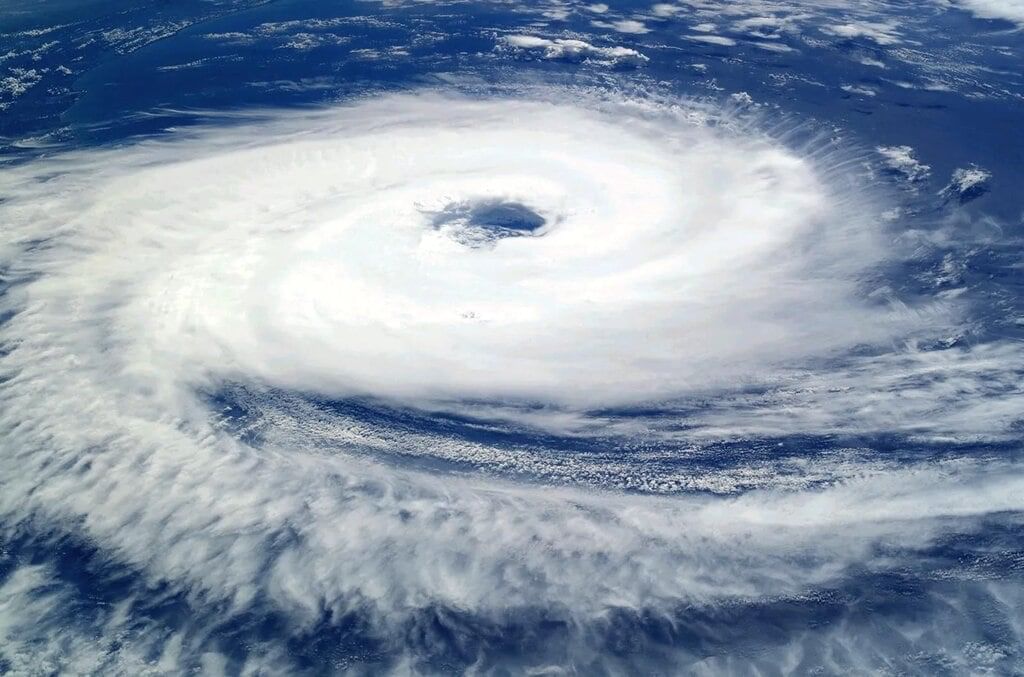 Cyclone
Cyclone
Very Short Answer Questions
Instruction: Answer the following questions in one line.
Q1. Why are dam walls broader at the base?
Q2. Why aren’t we crushed by atmospheric pressure?
Q3. What causes a sea breeze?
Q4. What simple safety rule helps prevent roofs from blowing off in storms?
Q5. What is a thunderstorm?
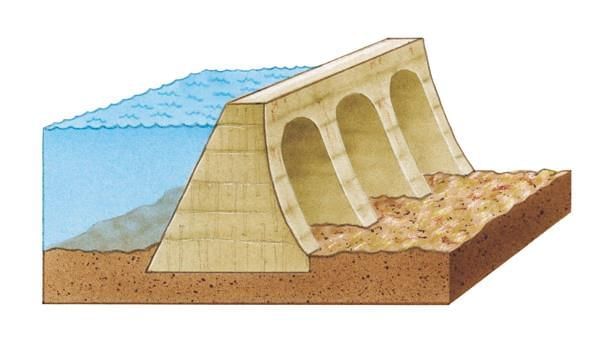 Dams are build borader at Base
Dams are build borader at Base
Short Answer Questions
Instruction: Answer the following questions in 2–3 lines.
Q1. Explain, with an example, how area affects pressure in daily life.
Q2. How does height of a liquid column affect pressure? Mention one application.
Q3. Describe briefly how winds are formed.
Q4. How does lightning form inside storm clouds?
Q5. Why are cyclones dangerous? Give two reasons.
Long Answer Questions
Q.1. Explain why snowshoes stop you from sinking into the snow.
Q.2. What is meant by atmospheric pressure?
Q.3. Why do the shape and size of balloons change when filled with air or water?
Q.4. Explain why the walls of a dam are thicker near the bottom than at the top.
Q.5. Explain why the tip of a sewing needle is sharp.
Q.6. Explain why, when a person stands on a cushion, the depression is much more than when he lies down on it.
Match the Following
Instruction: Match Column A with the correct option in Column B.
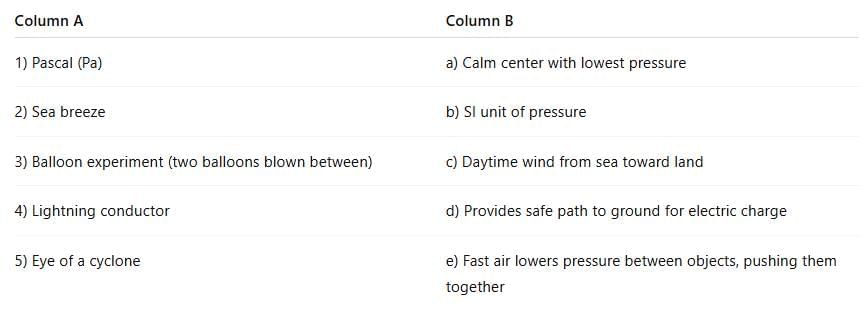
You can find the solutions of the worksheet here.
FAQs on Worksheet: Pressure, Winds, Storms, and Cyclones - Worksheets with Solutions for Class 8
| 1. What are the different types of winds and how do they affect weather patterns? |  |
| 2. How do storms form and what are the main types of storms? |  |
| 3. What is the relationship between atmospheric pressure and wind movement? |  |
| 4. What safety measures should be taken during a cyclone? |  |
| 5. What are the effects of cyclones on the environment and human life? |  |















